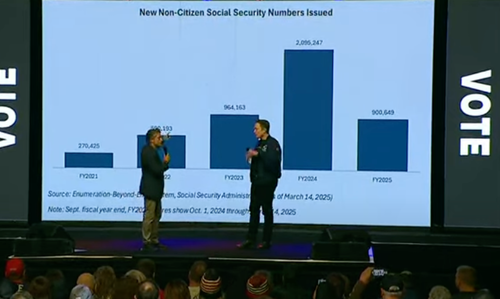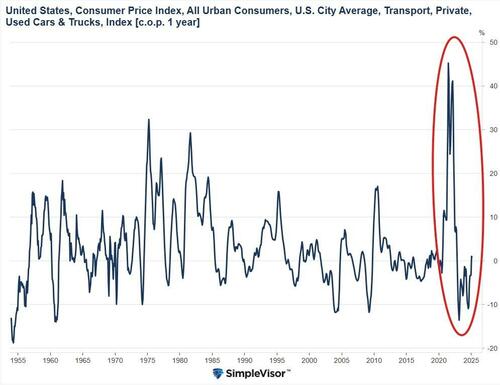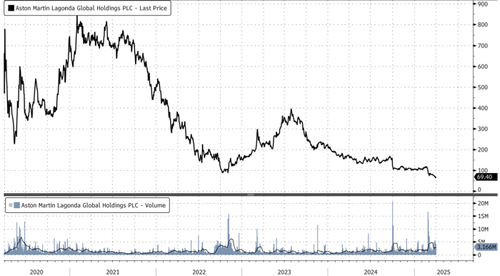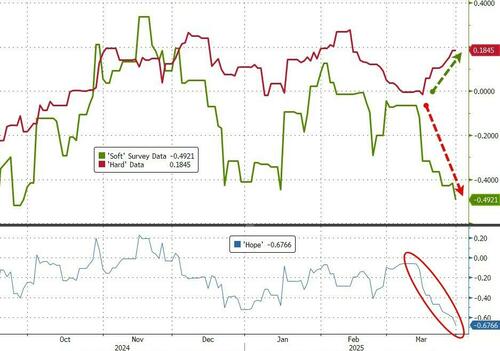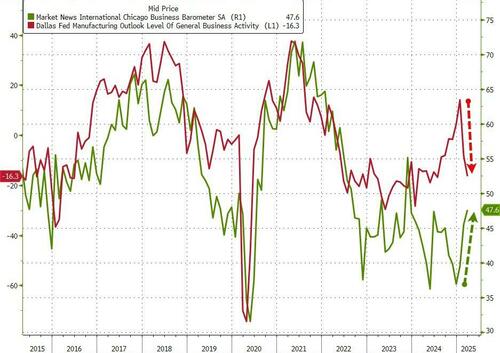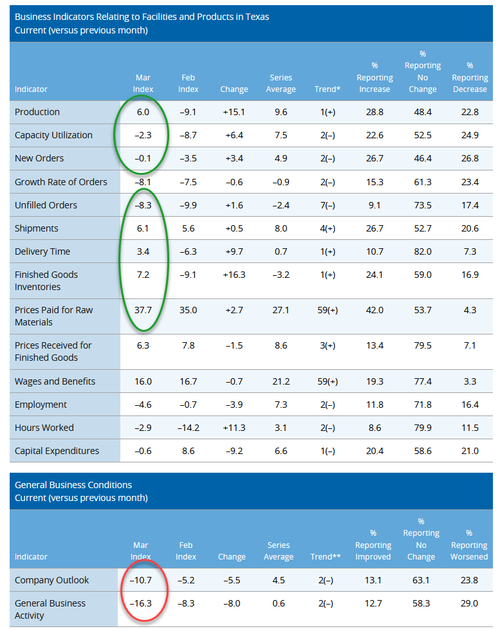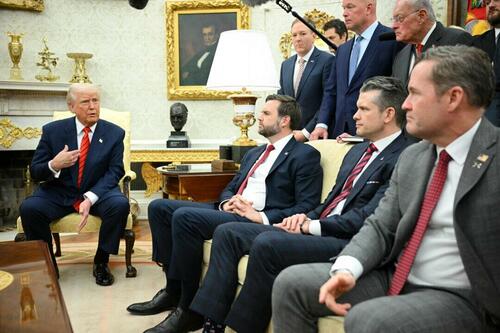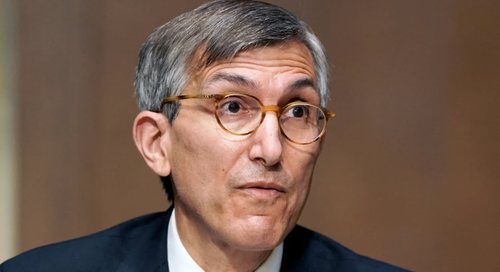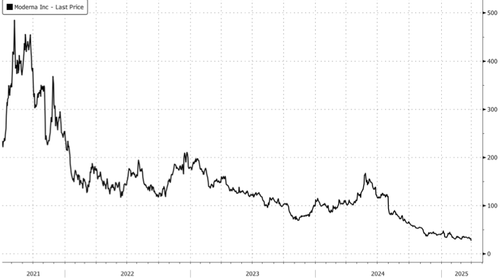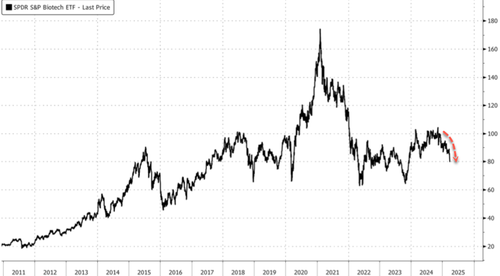Welcome to the last day of March ahead of the hotly anticipated “Liberation Day” on Wednesday. US and European markets are sharply lower and Asian equity markets are also sinking as the fear of what it may contain continues to build (the Nikkei tumbled into a correction overnight). As Goldman trader John Flood writes, “brace yourself for a crazy week ahead. S&P 500’s implied move through Friday” (4/4) is 260bps (he will take the over).
On the economic data front we get China’s NBS PMIs on Monday morning, US Manufacturing ISM (Tuesday morning; the Street is modeling 49.8, down from 50.3 in Feb), Services ISM (Thursday morning; the Street is modeling 53.1, down from 53.5 in Feb), and Jobs (Friday morning; the Street is modeling 135K, down from 151K in Feb, and according to Michael Hartnett this number is more important than Trump’s tariff announcement). Also need to keep an eye on the first major political contests since Trump’s reelection taking place on Tuesday 4/1 (the judicial election in Wisconsin and the special House races in Florida).
According to Flood, the Grand Daddy of this week’s events is the tariffs announcement on April 2: he notes that Goldman economists believe that “risks lean towards a negative surprise on announcement day for 2 main reasons: First, administration officials have said that the soon-to-be announced tariff rates are intended as the basis for negotiation, which incentivizes the proposal of higher rates at the outset. Second, their recent survey showed that market participants anticipate the reciprocal tariff rate to be 9% on average, while GS economists believe the initial proposal could be closer to double that expectation.”
Moving back to this week, outside of “liberation day” and 25% tariffs on imported autos commencing on Thursday, it’s also a big week for macro with all roads leading to Friday’s payrolls and a speech by Powell. Before that, the main highlights are: today’s German CPI; tomorrow’s US manufacturing ISM, US auto sales, US JOLTS, China’s manufacturing PMI, Japan’s Tankan, Eurozone CPI, the RBA rate decision, and a speech from Lagarde; Wednesday’s ADP report; Thursday’s US ISM services, China’s services PMI, Eurozone PPI, and the ECB account of the March meeting; all before the big end to the week on Friday.
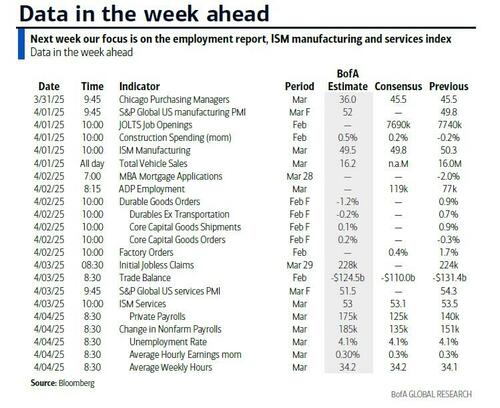
In terms of what to expect from “Liberation Day” on Wednesday, the bid-offer is huge. As DB’s economists laid out last week reciprocal tariffs could add roughly 4 (best case) to 14ppts (worst case) to the overall US tariff rate relative to its 2024 level of 2.5%. The hit to 2025 real US GDP growth could be as little as -25bps to as high as -120bps. For core PCE inflation, reciprocal tariffs could add anywhere from a couple of basis points to potentially 1.2ppts. Importantly, these impacts are additional to the risks to growth and inflation from previously announced tariff actions.
DB’s economists calculate that the trade actions taken to date (if they remain in place through year end) imply an overall US tariff rate of roughly 10.5%, which is the highest since WWII. The Trump Administration’s auto tariffs could push the US tariff rate as high as another couple of percentage points higher depending on the implementation details. So the starting point before “liberation day” is 10.5-12.5%. As such by the end of this week we could be looking at a aggregate US tariff rate of (very roughly) between 15 and 25%.
Over the weekend, Trump told NBC that he “couldn’t care less” if automakers had to raise prices in the US as it would force Americans to buy US made cars. The 25% tariffs are due to come into force on Thursday. So its becoming ever clearer that this administration is serious about bringing massive change to economic policy. If and where their pain threshold is in terms of markets and the economy is the next most important question. The rhetoric from the administration at the moment seems to suggest its high but there is an extraordinary amount of uncertainty at the moment.
The pain isn’t showing up in the hard data at the moment and in terms of US payrolls on Friday there’s only likely to be a small impact, DB forecasts +150k for both headline and private against +151k and +140k respectively last time. Incorporated in that is a roughly 20k drag from federal layoffs which have been complicated by court actions against them. DB expect the unemployment rate to just round up to 4.2% from 4.1% last time. Before that it will be interesting to see if the US manufacturing ISM (Tuesday) and services (Thursday) show any sentiment hit.
As an aside, several weeks ago, DB’s Jim Reid referred to a “rather insightful” podcast featuring US Treasury Secretary Scott Bessent on the “All-In” podcast (link here). He outlined his ideologies and, in my view, committed the administration to potentially transformative policies. Shortly thereafter, US Commerce Secretary Howard Lutnick appeared on the same podcast (link here) and presented perhaps an even more radical perspective on the potential policy direction.
As Reid notes today, “these are valuable podcasts to listen to and have helped convince me that this administration is serious about radical change.” We will have more to say about this shortly.
Back to this week’s events, tomorrow sees two special congressional elections in Florida to fill the seats of Matt Gaetz and Michael Waltz in the US House of Representatives. These are Republican strongholds but some polling has suggested it could be close. The Republicans will still control the House regardless but only have the narrowest of majorities so these are important elections in terms of breathing space for their agenda.
In geopolitics, the focus will be on a meeting of NATO foreign ministers on April 3-4. Its the first time they’ve met since Trump’s inauguration. So they’ll have plenty to discuss
Staying on this theme, over the weekend, Trump suggested he was angry at Putin over his recent comments that Zelenskiy should be replaced as a price for peace negotiations. Mr Trump used slightly stronger language according to NBC. Trump said that if Russia was to blame for there being no peace deal he’s prepared to put secondary sanctions on Russian oil.
Courtesy of DB, here is a day-by-day calendar of events
Monday March 31
- Data: US March MNI Chicago PMI, Dallas Fed manufacturing activity, China March official PMIs, UK March Lloyds Business Barometer, February net consumer credit, M4, Japan February industrial production, retail sales, housing starts, Germany March CPI, February retail sales, import price index, Italy March CPI
- Central banks: ECB’s Panetta and Villeroy speak
Tuesday April 1
- Data: US March ISM index, Dallas Fed services activity, total vehicle sales, February JOLTS report, construction spending, China March Caixin manufacturing PMI, Japan Q1 Tankan survey, February jobless rate, job-to-applicant ratio, Italy March manufacturing PMI, new car registrations, budget balance, February unemployment rate, Eurozone March CPI, February unemployment rate, Canada March manufacturing PMI
- Central banks: Fed’s Barkin speaks, ECB’s Lagarde and Lane speak, BoE’s Greene speaks, RBA decision
- Other: US House special elections in Florida
Wednesday April 2
- Data: US March ADP report, February factory orders, Japan March monetary base, France February budget balance
- Central banks: Fed’s Kugler speaks, ECB’s Schnabel and Escriva speak
Thursday April 3
- Data: US March ISM services, February trade balance, initial jobless claims, UK March official reserves changes, China March Caixin services PMI, Italy March services PMI, Eurozone February PPI, Canada February international merchandise trade, Switzerland March CPI
- Central banks: Fed’s Jefferson and Cook speak, ECB’s account of the March meeting, BoE’s March DMP survey
- Other: Nato foreign ministers meeting, through April 4
Friday April 4
- Data: US March jobs report, UK March new car registrations, construction PMI, Japan February household spending, Germany March construction PMI, February factory orders, France February industrial production, Italy February retail sales, Canada March jobs report, Sweden March CPI
- Central banks: Fed’s Powell and Barr speak
* * *
Finally, looking at just US macro, the key economic data releases this week are the ISM report on Tuesday and the employment situation report on Friday. President Trump is expected to announce new tariff policies on Wednesday. There are several speaking engagements from Fed officials this week, including speeches by Vice Chair Jefferson on Thursday and by Chair Powell on Friday.
Monday, March 31
- 09:45 AM Chicago PMI, March (consensus 45.0, last 45.5)
- 10:30 AM Dallas Fed manufacturing index, March (consensus -5.0, last -8.3)
Tuesday, April 1
- 09:00 AM Richmond Fed President Barkin (FOMC non-voter) speaks: Richmond Fed President Thomas Barkin will discuss monetary policy and the economic outlook at an event hosted by the Council on Foreign Relations. On March 28th, President Barking noted that the rapid policy changes implemented and proposed by the Trump administration have created “a sense of instability” in the business community that could “quiet demand.” Barkin characterized the current stance of monetary policy as “moderately restrictive,” which he said was a “good place to be.” He also said that he was “open to the notion” that tariffs would provide a one-time boost to the price level rather than a persistent boost to the inflation rate but noted that he did not “start with [that] assumption,” in part because inflation expectations “have been loosened—not de-anchored, loosened—for both price setters and price receivers” after the recent inflationary episode.
- 09:45 AM S&P Global US manufacturing PMI, March final (consensus 49.8, last 49.8)
- 10:00 AM Construction spending, February (GS +0.3%, consensus +0.3%, last -0.2%)
- 10:00 AM JOLTS job openings, February (GS 7,500k, consensus 7,680k, last 7,740k): We estimate that JOLTS job openings declined to 7.5mn in February based on the signal from online job postings.
- 10:00 AM ISM manufacturing index, March (GS 49.5, consensus 49.5, last 50.3): We estimate the ISM manufacturing index declined by 0.8pt to 49.5 in March, reflecting softer manufacturing surveys so far for March (GS manufacturing survey tracker: -0.6pt to 51.7) but a tailwind from residual seasonality.
- 05:00 PM Lightweight motor vehicle sales, March (GS 16.4mn, consensus 16.0mn, last 16.0mn)
Wednesday, April 2
- 08:15 AM ADP employment change, March (GS +110k, consensus +120k, last +77k)
- 10:00 AM Factory orders, February (GS +0.3%, consensus +0.5%, last +1.7%); Factory orders ex-transportation, February (consensus +0.4%, last +0.2%); Durable goods orders, February final (consensus +0.9%, last +0.9%); Durable goods orders ex-transportation, February final (consensus +0.7%, last +0.7%); Core capital goods orders, February final (last -0.3%); Core capital goods shipments, February final (last +0.9%)
- 04:30 PM Fed Governor Kugler speaks: Fed Governor Adriana Kugler will deliver a speech on inflation expectations and monetary policy at the Griswold Center for Economic Policy’s 2025 Public Talk. Text and Q&A are expected. On March 25th, Governor Kugler said that the FOMC was “well positioned” and could “react to new developments by holding at the current rate for some time as we closely monitor incoming data and the cumulative effects of new policies.” Kugler highlighted that goods inflation had “turned positive in recent months,” which she said was “unhelpful because goods inflation has often kept a lid on total inflation and also affects inflation expectations.”
Thursday, April 3
- 08:30 AM Trade balance, February (GS -$126.0bn, consensus -$123.4bn, last -$131.4bn)
- 08:30 AM Initial jobless claims, week ended March 29 (GS 230k, consensus 225k, last 224k); Continuing jobless claims, week ended March 22 (consensus 1,867k, last 1,856k)
- 09:45 AM S&P Global US services PMI, March final (consensus 54.1, last 54.3)
- 10:00 AM ISM services index, March (GS 52.5, consensus 53.0, last 53.5): We estimate that the ISM services index declined to 52.5 in March, reflecting sequential softening in our non-manufacturing survey tracker (-0.5pt to 52.6 in March) and a headwind from residual seasonality.
- 12:30 PM Fed Vice Chair Jefferson speaks: Fed Vice Chair Philip Jefferson will deliver a speech on the economic outlook and central bank communication at a conference hosted by the Atlanta Fed. Text and Q&A are expected. On February 19th, Vice Chair Jefferson said that “monetary policy remains restrictive,” but that “with a strong economy and a solid labor market, we can take our time to assess the incoming data to make any further adjustments to our policy rate.”
- 02:30 PM Fed Governor Cook speaks: Fed Governor Lisa Cook will deliver a speech on the economic outlook at the University of Pittsburgh. Text and Q&A are expected.
Friday, April 4
- 08:30 AM Nonfarm payroll employment, March (GS +150k, consensus +138k, last +151k); Private payroll employment, March (GS +160k, consensus +130k, last +140k); Average hourly earnings (MoM), March (GS +0.3%, consensus +0.3%, last +0.3%); Unemployment rate, March (GS 4.1%, consensus 4.1%, last 4.1%): We estimate nonfarm payrolls rose 150k in March. On the positive side, big data indicators pointed to a solid pace of job creation. The return of striking workers will be a 15k net boost, according to the strike report, and we expect a rebound in hiring among weather-sensitive industries following the particularly cold weather in January and February. On the negative side, we expect a moderate hit—we assume 25k—from the combined reduction in force actions of the federal government and a more moderate, but still positive, pace of state and local hiring (+15k). We estimate that the unemployment rate was unchanged at 4.1% on a rounded basis and that the participation rate was unchanged at 62.4%. We estimate average hourly earnings rose 0.3% (month-over-month, seasonally adjusted), reflecting positive calendar effects.
- 11:25 AM Fed Chair Powell speaks: Fed Chair Jerome Powell will deliver a speech on the economic outlook at the Society for Advancing Business Editing and Writing’s Annual Conference. Text and Q&A are expected. We saw Chair Powell’s comments at the press conference after the March FOMC meeting as somewhat dovish. Powell downplayed the sharp increase in Michigan inflation expectations, noted that other measures have been more stable, and said that the baseline is that tariffs will only delay further progress on inflation until 2026. He also reiterated that the FOMC was well positioned to wait for further clarity and not in a hurry to cut again.
- 12:00 PM Fed Governor Barr speaks: Fed Governor Michael Barr will deliver a speech on artificial intelligence and banking. Text and Q&A are expected.
- 12:45 PM Fed Governor Waller speaks: Fed Governor Christopher Waller will take part in an event on payment systems at a conference hosted by the New York Fed. Q&A is expected. Governor Waller dissented from the FOMC’s decision to slow the pace of balance sheet runoff at its March meeting. In a statement explaining his dissent, Waller said he thought that reserves were not yet “closer to an ample level of reserves” that he saw as an appropriate place to slow or stop balance sheet runoff. Waller also said that the FOMC had a “variety of tools” to address “unanticipated disturbances to reserve demand” should they emerge. On March 6th, Waller argued that the FOMC’s ability to lower the fed funds rate this year would “depend on our ability to tease out the effects of tariffs” on inflation. He also noted that “the uncertainty around tariffs has caused a lot of caution from the private sector and households.”
Source: DB, Goldman
